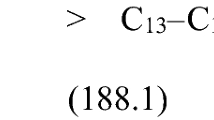Abstract
The kinetics of the formation of oxygen-containing compounds during oxycracking of vacuum gas oil was experimentally studied. The kinetic parameters of the process of formation of oxygen-containing compounds in five target fractions under oxycracking conditions are established: reaction rates, rate constants, reaction orders, activation energies. The average reaction rate of the formation of oxygen-containing compounds in oxycracking products in the first 600 s is limited by the rate of oxidation of the C10–C12 fraction, further from 600 up to 900 s by the oxidation of the C5–C9 fraction (during this period, the direction/mechanism of the formation of OCC in this fraction changes), and after 900 s—the fractions C1–C4. The presence of the induction period indicates that the formation of oxygen-containing compounds in the C1–C4 fraction occurs according to the unbranched chain mechanism, and C5–C9 and C22–C30—through the chain with degenerate branching. The combination of experimental and calculated data indicates a joint homogeneous heterogeneous oxycracking mechanism of vacuum gas oil, which excludes the single-valued contribution of only the volume or only the surface of the catalyst. It is shown that under oxycracking conditions the process proceeds both in the kinetic and in the internal transition region, depending on the temperature.





Similar content being viewed by others
References
Kissin YV (2001) Chemical mechanisms of catalytic cracking over solid acidic catalysts: alkanes and alkenes. J Catal Rev Sci Eng 43(1–2):85–146. https://doi.org/10.1081/CR-100104387
Fonseca N, Lemos F, Laforge S, Magnoux P, Ramôa-Ribeiro F (2010) Influence of acidity on the H-Y zeolite performance in n-decane catalytic cracking: evidence of a series/parallel mechanism. Reac Kinet Mech Cat 100(2):249–263. https://doi.org/10.1007/s11144-010-0197-8
Marcelo J, Souza B, Antonio O, Silva S, Fernandes VJ Jr, Araujo AS (2003) Catalytic cracking of C5+ gasoline over HY zeolite. React Kinet Catal Lett 79(2):257–262. https://doi.org/10.1023/A:1024530017369
Sertić-Bionda K, Gomzi Z, Fabulić-Ruszkowski M, Muźic M (2008) Study of nonisothermal gas-oil catalytic cracking applying the microactivity test. Pet Chem 48(1):6–14
Das AK, Wojciechowski BW (1993) A one-parameter model of catalyst deactivation for FCC modeling. Chem Eng Sci 48(6):1041–1049. https://doi.org/10.1016/0009-2509(93)81034-S
Hadzhieva SN (1982) Kreking neftyanyih fraktsiy na tseolitsoderzhaschih katalizatorah. Himiya, Moskva
Usmana A, Siddiqui AB, Hussain A, Aitani A, Al-Khattaf S (2017) Catalytic cracking of crude oil to light olefins and naphtha: experimental and kinetic modeling. Chem Eng Res Des 120:121–137. https://doi.org/10.1016/j.cherd.2017.01.027
Golrokh Sania A, Ebrahim A, Azarhoosh MJ (2018) 8-Lump kinetic model for fluid catalytic cracking with olefin detailed distribution study. Fuel 225:322–335. https://doi.org/10.1016/j.fuel.2018.03.087
John YM, Mustafa MA, Patela R, Mujtaba IM (2019) Parameter estimation of a six-lump kinetic model of an industrial fluid catalytic cracking unit. Fuel 235:1436–1454. https://doi.org/10.1016/j.fuel.2018.08.033
Ebrahimi AA, Mousavi H, Bayesteh H, Towfighi J (2018) Nine-lumped kinetic model for VGO catalytic cracking; using catalyst deactivation. Fuel 231:118–125. https://doi.org/10.1016/j.fuel.2018.04.126
Nazarova G, Ivashkina E, Ivanchina E, Kiseleva S, Stebeneva V (2015) Formalization of hydrocarbon conversion scheme of catalytic cracking for mathematical model development. IOP Conference Series: Earth and Environmental Science 27: 012062. https://doi.org/10.1088/1755-1315/27/1/012062
Jarullah AT, Awad NA, Mujtaba IM (2017) Optimal design and operation of an industrial fluidized catalytic cracking reactor. Fuel 206:657–674. https://doi.org/10.1016/j.fuel.2017.05.092
Mursalova LA, Бaгиpoвa HH, Adzhamov KYu (2019) Computational determination of conditions for the vacuum gas oil oxycracking process. Pet Chem 59(2):180–185. https://doi.org/10.1134/S0965544119020075
Mursalova LA, Guseinova EA, Adzhamov KY (2016) Acidic and basic properties of zeolite-containing cracking catalyst in the process of butene-1 isomerization. Russ J Phys Chem A 90(8):1533–1538. https://doi.org/10.1134/S0036024416080197
Mursalova LA, Guseinova EA, Adzhamov KY (2015) Features of the zeolite containing catalysts of oxidative catalytic cracking by thermal analysis EuropaCat XII. Catalysis: balancing the use of fossil and renewable resources. European Congress on Catalysis. Kazan, pp 1454–1455.
Semenov NN (1959) Some problems of chemical kinetics and reactivity, vol 2. Pergamon Press, New York
Lente G (2015) Deterministic kinetics in chemistry and systems biology: the dynamics of complex reaction Networks springer briefs in molecular science. Springer, New York, p 135. https://doi.org/10.1016/C2013-0-05256-5-16
Kiperman SL (1991) Kinetic models of heterogeneous catalytic reactions (review) Bulletin of the Academy of Sciences of the USSR. Div Chem Sci 40(12):2350–2365
Masel RI (2001) Chemical kinetics and catalysis. Wiley, New York, p 968
Engel TH, Reid PH (2013) Thermodynamics, statistical thermodynamics, & kinetics, 3rd edn. Pearson Education Inc, Boston, p 648
Somorjai GA, Li Y (2010) Introduction to surface chemistry and catalysis, 2nd edn. Wiley, New York, p 800
Paul A, Willems-Gilbert F (1988) Froment kinetic modeling of the thermal cracking of hydrocarbons. 2. Calculation of activation energies. Ind Eng Chem Res 27(11):1966–1971. https://doi.org/10.1021/ie00083a002
Montoya T, Argel BL, Nassar NN, Franco CA, Cortés FB (2016) Kinetics and mechanisms of the catalytic thermal cracking of asphaltenes adsorbed on supported nanoparticles. Pet Sci 13(3):561–571
Krylov OV (1995) Heterogeneous catalysis intermediates and mechanisms. Theor Exp Chem 31(4):169–179
Boreskov GK (1986) Heterogeneous catalysis. Nauka, Moscow, p 304. (In Russia)
Zel'dovich YB, Raizer YP (1968) Elements of gasdynamics and the classical theory of shock waves. Academic Press, Cambridge, p 115
Author information
Authors and Affiliations
Corresponding author
Additional information
Publisher's Note
Springer Nature remains neutral with regard to jurisdictional claims in published maps and institutional affiliations.
Rights and permissions
About this article
Cite this article
Guseinova, E.A., Adzhamov, K.Y. & Safarova, S.R. Kinetic parameters of the formation of oxygen-containing compounds in the vacuum gas oil oxycracking process. Reac Kinet Mech Cat 129, 925–939 (2020). https://doi.org/10.1007/s11144-020-01725-8
Received:
Accepted:
Published:
Issue Date:
DOI: https://doi.org/10.1007/s11144-020-01725-8




